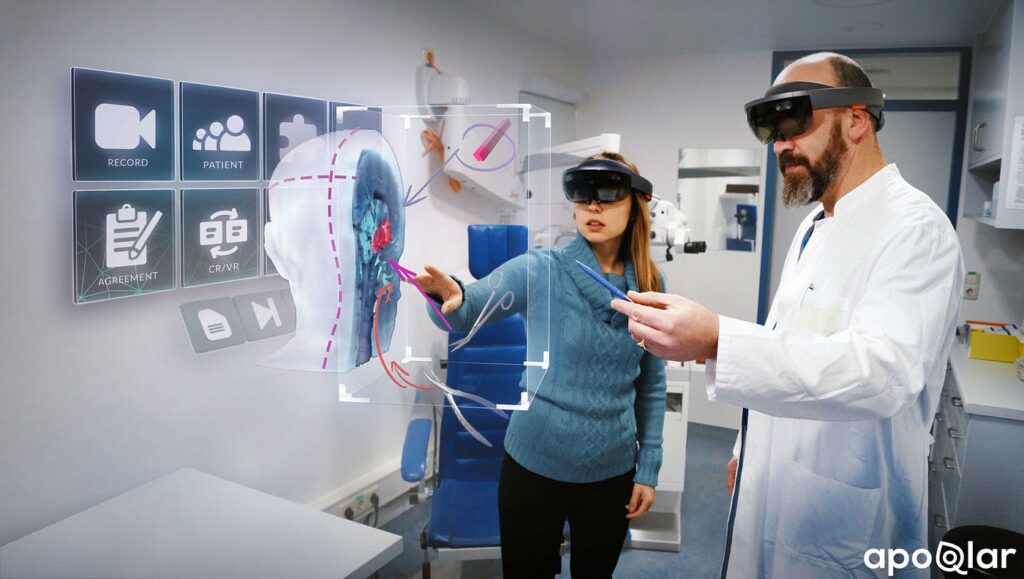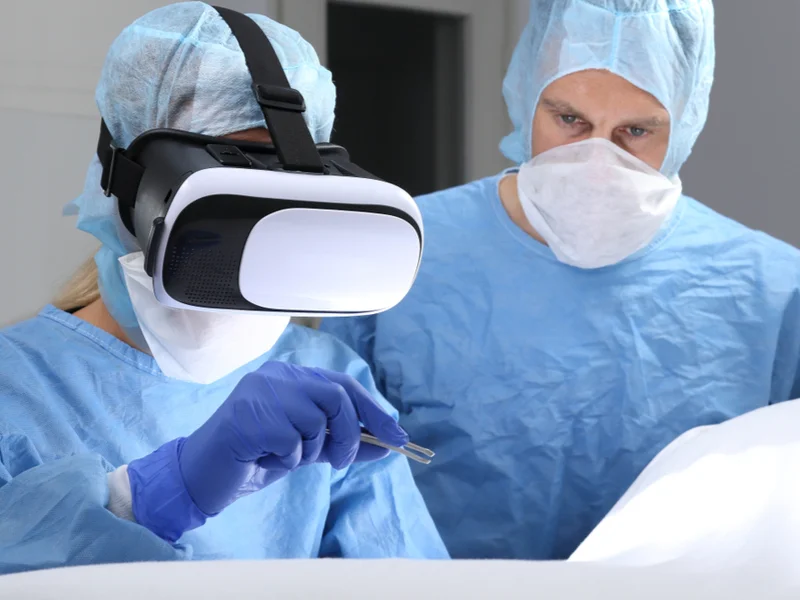AR/VR
AR stands for Augmented Reality, while VR stands for Virtual Reality. AR combines digital elements with real-life, physical elements while VR is fully artificial and immersive.
Augmented Reality (AR) is a technology that overlays digital information, such as images, videos, or 3D models, onto the real world.

AR can be experienced through smartphones, tablets, smart glasses, or specialized headsets.
Virtual Reality, on the other hand, creates a completely immersive digital environment that replaces the real world. By wearing a VR headset, users are transported to a virtual world where they can interact with objects and explore different scenarios.
Healthcare refers to the organized system of services, facilities, professionals, and resources that are dedicated to the promotion, maintenance, and restoration of health and well-being for individuals and communities.
The healthcare industry has always been at the forefront of adopting ground-breaking technologies to improve patient care, enhance medical training, and advance research and diagnosis.
In recent years, the integration of Augmented Reality (AR) and Virtual Reality (VR) has brought about a significant transformation, revolutionizing the way healthcare professionals operate and patients experience medical treatments.
How is AR/VR impacting the healthcare industry?
Augmented reality (AR) and virtual reality (VR) have the potential to revolutionize the healthcare industry by enhancing patient care, improving medical training, and advancing research and diagnosis. Here are some key roles AR/VR can play in healthcare:
Medical Training and Education
AR/VR technologies can provide immersive and interactive learning experiences for medical professionals. Surgeons can practice complex procedures in virtual environments, allowing them to refine their skills without the need for a physical patient. Medical students can also benefit from realistic simulations, aiding in the understanding of anatomy, surgery, and patient interactions.
Surgical Planning and Guidance
AR can overlay digital information onto the real world, providing surgeons with real-time guidance during procedures. Surgeons can view patient data, such as medical imaging, directly in their field of vision, improving precision and reducing errors. This technology can assist in preoperative planning, anatomical visualization, and accurate placement of instruments during surgery.
Rehabilitation and Physical Therapy
VR can create immersive environments that aid in the rehabilitation process. Patients can engage in interactive exercises and simulations to regain motor skills, balance, and coordination. VR-based therapy has shown promising results in treating conditions such as stroke, traumatic brain injuries, and post-traumatic stress disorder (PTSD).
Mental Health Treatment
AR/VR can be used as therapeutic tools in mental health treatment. VR environments can simulate real-world scenarios, exposing individuals to controlled environments to treat phobias, anxiety disorders, and post-traumatic stress. AR applications can assist therapists by overlaying information and visual cues during therapy sessions.
Pain Management
AR/VR can help distract patients from pain and discomfort during medical procedures. By immersing patients in engaging virtual environments, healthcare providers can reduce the need for high doses of pain medication and alleviate anxiety and distress.
Telemedicine and Remote Consultations
AR/VR technologies enable remote collaboration and consultation between healthcare professionals. Specialists can virtually join a surgical procedure, provide guidance, and communicate with the operating team in real-time. Virtual visits can also enhance telemedicine experiences by allowing doctors to examine patients remotely using AR/VR tools.
Research and Development
AR/VR can facilitate medical research by providing new avenues for data visualization, analysis, and exploration. Scientists can use immersive technologies to study complex biological structures, analyze medical imaging data, and simulate drug interactions, leading to faster discoveries and more efficient development of treatments.
The role of AR/VR in the healthcare industry is continuously evolving as technology advances, and it has the potential to improve patient outcomes, enhance medical training, and transform the way healthcare is delivered.
Real World Examples of AR/VR in healthcare services
Some specific healthcare products where AR/VR is implemented:
AccuVein
AccuVein uses AR technology to visualize and map veins on a patient’s skin, making it easier for healthcare professionals to locate veins for blood draws, IV insertions, and other procedures.
EchoPixel
EchoPixel creates 3D virtual models of patient anatomy using VR technology. This allows surgeons to interact with and explore patient-specific anatomical structures for preoperative planning and surgical guidance.
Osso VR
Osso VR offers a virtual training platform for surgical procedures. It provides realistic simulations and haptic feedback to train surgeons and other healthcare professionals in a virtual environment.
Surgical Theater
Surgical Theater develops virtual reality solutions that enable surgeons to immerse themselves in patient-specific 3D reconstructions of anatomy. This technology assists in preoperative planning, navigation during surgery, and patient education.
DeepStream VR
DeepStream VR has developed a VR-based software platform called “COOL!” that helps manage chronic pain without the need for medication. It uses immersive experiences and cognitive behavioral therapy techniques to distract patients from pain and teach them pain management strategies.
Augmedix
Augmedix is an AR-based platform that provides remote medical documentation and scribing services. It uses smart glasses to enable healthcare professionals to document patient encounters in real-time while maintaining eye contact with the patient.
SimX
SimX offers an AR/VR simulation platform for medical training. It allows medical students and professionals to practice emergency medical procedures, patient assessment, and critical decision-making in realistic virtual environments.
Psious
Psious develops VR-based applications for the treatment of anxiety disorders, phobias, and other mental health conditions. It provides exposure therapy simulations in virtual environments to help patients confront and overcome their fears.
HoloLens for Healthcare
Microsoft’s HoloLens is being implemented in various healthcare applications, including surgical planning, medical education, and telemedicine. It overlays holographic images and information onto the real world, assisting healthcare professionals in various tasks.
ImmersiveTouch
ImmersiveTouch offers VR-based surgical planning and simulation tools. Surgeons can use their platform to practice procedures and interact with patient-specific anatomical models, improving surgical accuracy and outcomes.
These are just a few examples of healthcare products where AR/VR technologies are being implemented. The field is rapidly evolving, and new products and applications continue to emerge as technology advances.
Growth of AR/VR in recent years
The AR/VR market in healthcare has witnessed remarkable growth, with a surge in innovative solutions and widespread adoption across various healthcare domains.
Expanding Applications in Healthcare
The applications of AR/VR in the healthcare industry have expanded rapidly, encompassing a wide range of use cases. From surgical navigation and medical imaging to rehabilitation and mental health treatment, AR/VR technologies have demonstrated their potential to revolutionize healthcare delivery.
One of the key areas where AR/VR has made substantial progress is in surgical procedures. Surgeons can now leverage AR-based surgical navigation systems, which provide real-time guidance and overlays of patient data directly onto the surgical field. This technology improves precision, reduces errors, and enhances surgical outcomes.

Medical imaging and visualization have also been revolutionized by VR. With VR headsets, healthcare professionals can immerse themselves in 3D reconstructions of patient anatomy, facilitating better diagnosis, treatment planning, and patient education. The ability to manipulate and interact with virtual anatomical structures has significantly enhanced the understanding of complex medical cases.
Rehabilitation and physical therapy have witnessed a paradigm shift with the integration of VR. Patients can engage in immersive virtual environments, which facilitate exercises and simulations for regaining motor skills, balance, and coordination. VR-based therapies have shown promising results in treating conditions such as stroke, traumatic brain injuries, and PTSD.
In the realm of mental health, AR/VR has emerged as a powerful tool. Virtual reality exposure therapy (VRET) provides a controlled and immersive environment for treating phobias, anxiety disorders, and PTSD. By exposing patients to virtual scenarios that trigger their fears, therapists can guide them through the process of overcoming those fears in a safe and controlled manner.
Market Growth and Adoption
The market growth of AR/VR in the healthcare industry has been remarkable in recent years. According to market research, the global AR/VR healthcare market was valued at $1.82 billion in 2020 and is projected to reach $7.05 billion by 2026, growing at a CAGR of 29.6% during the forecast period.
Several factors have contributed to the rapid adoption of AR/VR technologies in healthcare. The increasing availability of affordable VR headsets and AR devices has made the technology more accessible to healthcare providers. Advances in computing power and graphics capabilities have also enabled more sophisticated and realistic simulations, further driving adoption.
Moreover, the COVID-19 pandemic has acted as a catalyst for the adoption of AR/VR in healthcare. The need for remote consultations, telemedicine, and virtual training skyrocketed during the pandemic, and AR/VR technologies provided viable solutions. These technologies enabled healthcare professionals to connect with patients remotely, perform virtual assessments, and conduct medical training and education virtually.

The Future of AR/VR in Healthcare
The future of AR/VR in the healthcare industry is bright, with immense potential for growth and innovation. As technology continues to advance, we can expect even more sophisticated applications and widespread adoption across healthcare domains.

Further developments in hardware, such as more compact and user-friendly headsets, will drive broader adoption among healthcare professionals. Improvements in haptic feedback technology will enhance the sense of touch and enable more realistic interactions in virtual environments.
Additionally, the integration of AR/VR with other emerging technologies, such as artificial intelligence and robotics, holds great promise. AI-powered algorithms can analyze medical imaging data in real-time and provide actionable insights to surgeons during procedures. Robotics combined with AR/VR can enhance telemedicine capabilities by enabling remote robotic-assisted surgeries, with surgeons operating from distant locations.
Conclusion
The growth of AR/VR in the healthcare industry has been transformative, with its applications spanning surgical procedures, medical imaging, rehabilitation, mental health treatment, and more. The market has experienced rapid expansion, driven by technological advancements, increasing affordability, and the demands of a changing healthcare landscape.
As AR/VR technologies continue to mature, we can expect to witness even greater advancements in patient care, medical training, and research. The potential to improve surgical outcomes, enhance diagnostic capabilities, and transform therapy approaches is immense. The integration of AR/VR with other emerging technologies further expands the possibilities for revolutionizing healthcare delivery, making it an exciting time for the industry and paving the way for a future where AR/VR becomes an integral part of standard healthcare practices.


